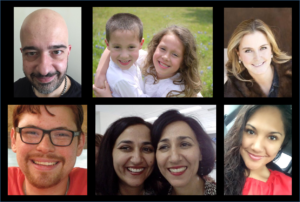By Amy Grace
It was Friday a few weeks ago, and I was stuck in traffic. The highway was a parking lot, and I was trying not to pull my hair out in frustration. As fate would have it, there was another person stuck in the same traffic, a mom whose path would cross with mine a few days later. While I was fidgeting and fuming over the traffic delay, she was receiving a phone call in her car that her home was on fire with her children in it. Really puts things in perspective, doesn’t it?
This mom contacted the Red Cross for help after losing many of their family’s possessions, and I was sent to assess the damage to the home and to determine what immediate needs we might help meet.
Upon arriving at the townhouse, I noticed the upstairs windows were broken out and black with smoke residue, but, for the most part, the home didn’t look that damaged. Then I walked into the house and changed my mind. As I headed up the stairs, my stomach twisted in knots seeing paint scorched, wood warped and everything just blacker and blacker as I got closer to the source of the fire…the bedroom of a little five-year old boy. There was nothing left in that room. Every toy, the bed, clothes – everything, in every corner was turned to ash or to melted versions of what it had been. The little boy’s mom was standing right behind me. I turned to her and asked, “How did he make it out of here?” With tears in her eyes, she pointed to the smoke alarm. It had notified the other adults in the home when the fire started, and they had been able to get everyone out to safety. Without that early warning, the outcome for this mom might have been very different. The call she received in her car might have been much more devastating.
A few months ago I accepted the position of Executive Director for the Heart of Texas Chapter of Red Cross. Like most people, I was familiar with Red Cross, but I quickly found out that what I knew about the Red Cross was not anywhere near the whole story.
Most people know that Red Cross responds when disaster strikes. Yes, our definition of “disaster” includes catastrophic events that affect masses of people, but we also recognize and assist in much smaller disasters, events that most of us will never hear about but that can rock a person, or a family, to the core. We respond to home and apartment fires like the one described above every day. We provide comfort and meet immediate needs for food, shelter and clothing for hundreds of families a year. I had no idea.
In addition to responding to fires, the Red Cross also works hard to prevent fires from taking a devastating toll. For example, we have a program to install smoke alarms in any home that needs them – for free. We are also equipping our community’s children to understand and be prepared for disasters like home fires, tornadoes and flooding. Through a joint effort with Disney called “The Pillowcase Project,” we are targeting 3rd through 5th graders in a fun, hands on session ab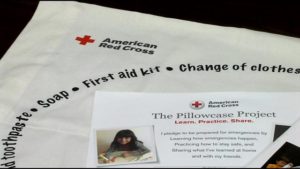 out disaster preparedness and safety. We are partnering with the YMCA of Waco to deliver this to students in their after-school programs this fall.
out disaster preparedness and safety. We are partnering with the YMCA of Waco to deliver this to students in their after-school programs this fall.
I wish to never again see the gut-punched, empty-eyed look on another adult or child’s face after they have lost everything, sometimes including loved ones, to a fire. The Red Cross is working hard to make that wish a reality.
The Red Cross also makes sure that firefighters battling wildfires get water and food, that patients needing blood transfusions have access to that life giving resource, that our military service members receive vital help and support when they need it, and that care givers for your children are trained to save those precious little lives. Before I came to work here, I had no idea the Red Cross did all these things, and I bet some of you didn’t know it either.
The Red Cross mission is lived out in our community, right here in Waco, every day of the week, by a handful of incredible volunteers and a few staff members who get up at all hours of the night to make sure every home fire victim we are called upon to help, gets that help. That is who we are here at the Red Cross.
My team members and I work tirelessly to make sure you, our neighbors, get the help you need when you need it… and we need your help! The people driving with you on the road, sitting with you in restaurants, walking around the mall or grocery store with you… they need your help. We never know when disaster will strike or where. How can you help? Become a Red Cross volunteer here in our community and help people be prepared for and cope with disasters in our own back yard. Or, give to our mission financially to help protect and support more and more families. Whatever route you choose to help, thank you in advance – you are extremely appreciated.
If you have questions or want to learn more, you can call our office at (254) 523-4985, call me directly at (254) 447-1625, or visit us online at www.redcross.org to explore volunteer and donation opportunities, and to learn more about our Home Fire Preparedness Campaign and Pillowcase Project.
Thank you for reading!
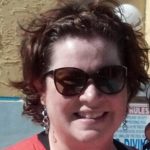 Amy Grace is a native Texan serving our community as the Executive Director of the Heart of Texas chapter of the American Red Cross. She has an extensive professional background but is most proud of being a mom to her incredible four-year old daughter and paying forward a legacy of courage, resilience, hope and abundance. She currently resides in Temple with her daughter, two canine family members (Ranger and Silver) and her grandmother.
Amy Grace is a native Texan serving our community as the Executive Director of the Heart of Texas chapter of the American Red Cross. She has an extensive professional background but is most proud of being a mom to her incredible four-year old daughter and paying forward a legacy of courage, resilience, hope and abundance. She currently resides in Temple with her daughter, two canine family members (Ranger and Silver) and her grandmother.
The Act Locally Waco blog publishes posts with a connection to these aspirations for Waco. If you are interested in writing for the Act Locally Waco Blog, please email [email protected] for more information.
By Sarah Frances Moran
I’ve written poetry since I was a teenager and since that time was very good at keeping it nice and hidden in my journals. It made the occasional appearance with girlfriends (girls love, love poems!) and the occasional appearance with family. Otherwise, it was never shared. Never. The thought of sharing my work publicly, whether at open mics or by submitting it to journals was horrifying.
I moved to Waco in July of 2013 and decided in the summer of 2014 that I needed to look into whether Waco offered any open mic type events so I could continue sitting in the corner hiding my work! That’s when I came across Waco Word Fest (a part of the Waco Cultural Arts Fest). I’d missed the majority of the event but did manage to make it to the 100thousand Poets for Change reading and that’s where I met Jenuine Poetess, local advocate for all things art. The event was organized and encompassed this wide variety of beautiful voices. She engaged the crowd, took photos and was extremely encouraging and welcoming. I was impressed. At the event flyers were passed out about other events. It was here that I learned about the Waco Poet’s Society and the In The Words of Womyn writing group.
My journey to finding an open mic venue brought me to meeting with Jenuine and a beautiful group of women writers on Monday evenings. I began sharing my work and my voice. Shortly after, I attended a Nuestra Voz open mic hosted by Jenuine and Waco Poet’s Society. For the first time in my life I got the courage to get up in front of an audience of strangers and read my most personal work. I decided that I should start sending my own work out to be considered for publication in journals and magazines. In one year’s time I’ve had a ton of work published in a wide variety of journals, magazines and online blogs. I’ve begun to dabble in short stories, non-fiction and memoir writing. I’ve continued to read my work in front of audiences even when my voice quivers. I’ve been featured in Houston, and Austin, and in September I’ll be featured here in Waco. I’ve started my own journal, Yellow Chair Review, that is quickly growing beyond my wildest imaginations. This year at the 2015 Waco Word Fest I’ll be giving a workshop on publishing.
But this isn’t about me, this is simply why community is so so important. This is why holding space that is encouraging, comforting and open means so much.
I know my accomplishments are mine but they’re also Waco’s. This is where my voice was found and this is where it’s nurtured. This is where I’ve learned that my voice is important, that what I create is important and that I have nothing to fear by sharing it.
Imagine all of the Sarahs out there writing in journals, singing in the bathtub, painting in their bedrooms who are afraid. Imagine them never finding safe space. Imagine all of the creativity that never gets shared with the world.
Support the arts. Support the individuals like Jenuine volunteering their time to hold space to uplift voices.
These programs have nurtured and continue to nurture me an an artist. They are important and none of it is in vain. I’m proof of that.
 This Act Locally Waco blog post was written by Sarah Frances Moran. Sarah is the editor and founder of Yellow Chair Reviewand a member of the Waco Poet’s Society. To read more of her words please visit www.sarahfrancesmoran.com .
This Act Locally Waco blog post was written by Sarah Frances Moran. Sarah is the editor and founder of Yellow Chair Reviewand a member of the Waco Poet’s Society. To read more of her words please visit www.sarahfrancesmoran.com .
The Act Locally Waco blog publishes posts with a connection to these aspirations for Waco. If you are interested in writing for the Act Locally Waco Blog, please email [email protected] for more information.
By Eric Martin
I love living in downtown Waco. We’ve got a gorgeous river, a sprawling urban park, a charming business district, a friendly and diverse community, and world-class higher education.
As I travel through Texas and around the world, my fondness for the city has made me a bit defensive about it. Defensive because of the nearly ubiquitous reactions that mention of “Waco” elicits from others. Waco, as you likely know, has a worldwide reputation. In many folks’ minds, Waco is not just where the Branch Davidian siege and biker-gang-shootouts happened to take place. Unfortunately and unfairly, for many, Waco represents the kind of place where those sorts of things occur: backward, gun-crazy, with more than its share of religious fanatics.
Such interactions have sensitized me to widespread misconceptions about the South. As a native Midwesterner, I’m surprised to find myself in a position to convince friends and colleagues that their stereotypes are often untrue and unfounded.
That said, Waco has its struggles like any other city. And these challenges have been especially pronounced during the last half of the 20th century; we are now emerging from that period but those challenges still affect us today. For example, the lack of grocery stores means that on most days it’s impossible to buy fresh food for many miles around downtown. It’s an inconvenience for me, but a conspicuous public health problem for the city. Also, its infrastructure needs updating to make the city more accommodating for pedestrians, cyclists, and public transit users. Study after study shows that such urban development really matters: sidewalks, trees, and bike lanes are not only economically beneficial but actually make people happier and healthier.
These problems are intertwined with another, bigger one: lack of confidence in Waco schools.
As this website has highlighted, there are plenty of good-news stories emerging from Waco ISD, but I want to address the perception of problems just as much as any actual problems. Perceptions – even if they’re illusions – matter, since they have kept many more-resourced families away from downtown Waco.
Historically, downtown was hardly a place to avoid. Many Wacoans remember when downtown was a thriving business district that attracted people from all over. Downtown boasted theaters, stores, hotels, and streetcars: precisely the amenities world-class cities feature today. Its streets were packed with people. U.S. Presidents came to town; renowned theologian Dietrich Bonhoeffer even stopped here on a 1931 road trip.
In the 1990s, by contrast, Waco was known among Texans more as a bathroom stop along I-35; it was christened “Tinkletown” by one Baylor professor. One newspaper dubbed the Waco of this era “a shabby ghost town.”
I’ve asked a lot of questions about what exactly happened to this formerly thriving downtown, and there is one explanation that nearly everyone brings up: the 1953 tornado. Many Wacoans say that our formerly great city was blighted by this Act of God, and that downtown has simply never recovered from this natural disaster.
But that’s just one part of the story, and I’ve come to think that Waco’s decline is not nearly so much an act of God as many smaller acts of human sin. An F5 tornado, horrible as it was, is no match for the urban destruction wrought by human prejudice.
Coinciding with the tornado was the momentous Supreme Court decision, Brown vs. Board of Education, officially desegregating American schools. Desegregation was slow and piecemeal in Waco, but over the few years it was implemented, Waco ISD saw an exodus of over 5,000 students leave for surrounding suburbs[1]. It is clear that some people moved away from downtown Waco to move away from integrating with minority communities. Moreover, it is clear that many people today also choose their school districts in ways that effectively reinforce segregation, which harms students (not just poorer ones) in lots of ways.
This is not just a Waco problem: it’s an American problem, especially severe in the post-World War era of “white flight.” The combination of exclusive neighborhood covenants and the redlining procedures used by banks to segregate neighborhoods made for new ways of preserving old divisions. And because of America’s peculiar method of financing education through local property taxes, this system generates not only ethnic division, but less education funding for poorer families. America is one of the only developed nations that spends more public money on rich children than on poor children [2].
Segregation in American schools never really ended; it only changed forms by becoming privatized. Instead of segregated schools, we now have segregated neighborhoods. It’s not just about race, or even class: it’s about not wanting to live with people different from ourselves, coupled with legitimate (if muddled) fears of providing children with anything less than the best educations. This is certainly part of the explanation for Waco’s downtown decline.
The concentration of wealth and educational opportunity in segregated communities of privilege are understandable social phenomena. But these realities do not reflect especially loving or Christian values. To the contrary, I believe they are trends that Christians should be working to change.
Problems with race relations haunt America’s past, but we risk recapitulating these sins unless we identify them and address them head on. There are glaring disparities in class and ethnicity within steps of Baylor’s campus. The good news is that Baylor can help remedy these divisions. I single out Baylor because it’s the institution I’m currently part of, but I also believe it has the resources and the vision to make a real impact.
How can Baylor be a better neighbor in our community? One answer is simply to be a neighbor in our community – that is, to suggest that its employees might live here instead of elsewhere. When faculty and staff move to Waco to join Baylor, the university has often shepherded them off to distant suburbs. But Baylor should also promote downtown as a great place to live. Several new faculty members have recently made the decision to live centrally and I think even more will in the future.
Secondly, Baylor can provide volunteer experiences that are more than just passing events. Service opportunities should foster richer, more long-term interactions between students and the rest of the city, and help with problems identified by community members themselves. I have been impressed with the ways that Baylor pursues these goals, especially though its Office of Community Engagement and Service. Volunteering should be integral to the undergraduate experience.
And third, Baylor can actively promote diversity among our students, teachers and staff. We should strive to reflect the diversity of Texas and our nation, and be part of the best tradition of universities that become engines of social mobility. I would argue that Baylor, which was itself segregated for 70% of its own institutional history, has an added obligation to ameliorate the ongoing disparities along ethnic lines.
I love living in Waco, and want it to be a place where everyone has the opportunity to flourish. We can all work on being better neighbors.
 Eric Martin is a philosopher working at Baylor University’s Great Texts Program. Originally from Michigan, he studied in Colorado and California before taking his first academic position in London. After a few years overseas, he’s now happy to call Waco home. When he’s not at his desk he can be found exploring Cameron Park or riding his bicycle.
Eric Martin is a philosopher working at Baylor University’s Great Texts Program. Originally from Michigan, he studied in Colorado and California before taking his first academic position in London. After a few years overseas, he’s now happy to call Waco home. When he’s not at his desk he can be found exploring Cameron Park or riding his bicycle.
The Act Locally Waco blog publishes posts with a connection to these aspirations for Waco. If you are interested in writing for the Act Locally Waco Blog, please email [email protected] for more
Notes:
[1] Texas Education Agency Research Division, Public School Directory 1954-55 – 1984-85. These numbers are corroborated by anecdotal accounts of the city’s reaction to integration by residents and school officials. See also BU’s Institute of Oral History records: esp. Glenn R. Capp, Sr. (1976); Samuel K. Howard (1994); Pauline Adams (2002). Advocating desegregation in 1955 earned Capp personal threats and accusations of being a “communist” by the local White Citizens’ Council. Enthusiasm for integration was tempered by sometimes-tumultuous court-ordered school reorganizations, such as 1970’s consolidation of La Vega and Waco schools. Recent discussions of modern segregation include ProPublica’s Segregation Now and This American Life’s The Problem We All Live With.
[2] Organization for Economic Cooperation and Development, Education at a Glance 2013.
By Matthew Polk
The Prosper Waco initiative only works if community members come up with ideas that we can put into action together. You know more about your life and your community than anyone. You know what it will take for you to be able to take the next step toward success.
Prosper Waco is about:
- More kids being ready to learn when they start Kindergarten
- More students (and adults) finishing a college degree or certificate that will get them a good job
- More people knowing where they need to go to get the best healthcare…and being able to afford it
- More people living a healthy lifestyle and losing weight
- More youth (16-24 year olds) getting a job
- More people getting the job training they need to make a better living
- More people being able to save for their future
These are things we all want. There are ways to make them happen for people in our community. The City of Waco and this community are serious about helping people move forward successfully. But we can’t solve your problems without you. We need to work together to find answers to these challenges.
How can you help? Come share your ideas about how best to help people in our community improve their education, health, and financial security.
 Day: Thursday, September, 17th
Day: Thursday, September, 17th
Time: 6:30-8:00 p.m.
Where: City of Waco Multi-Purpose Building on Quinn Campus (next to the Doris Miller Y)
Details: FREE FOOD! FREE CHILDCARE!
(Thanks to our awesome partners at the Doris Miller Y for working with the kids!)
No need to RSVP. Bring yourself and invite others. This is a chance for us to have a conscious community discussion about how we can work together to help people improve their education, health, and financial security. You don’t need to know anything about Prosper Waco to be able to contribute to the conversation.
People want to invest in a community that is working together. Next week will be the first visit of our partners from the National Resource Network (NRN). This team of experts is funded by the Department of Housing and Urban Development to assist cities that are dealing with the impact of poverty.
The NRN team visited Waco in June and was impressed with the City leadership and their support of the Prosper Waco initiative. Like many others, the NRN team commented that Waco is ahead of many other cities in taking a coordinated approach to addressing poverty-related issues and helping people improve their education, health, and financial security.
The NRN experts will be visiting Waco on a monthly basis over the next year in order to help our community implement the strategies that we decide are the best bets for achieving the Prosper Waco goals listed above. Because they have worked with cities facing similar challenges across the country, the NRN team will be able to help us identify the best practices for doing work related to improving education, addressing community health needs, and developing the local workforce.
Next week, the NRN team will be meeting with a large number of people who are involved in the Prosper Waco initiative. When they return in October, we want to be able to share with them more feedback from the community about what needs to be done to make Prosper Waco a success. This is why we need you to be part of the discussion on September 17th.
Continue to stay informed about the Prosper Waco initiative and share what you learn with your friends and neighbors. Visit our website—www.prosperwaco.org—to find links to our monthly show on the City’s cable channel. Sign up for our email newsletter at the top of the homepage or click Contact to send us a quick comment or question. Check out the Calendar to see when various working groups are meeting, and click Get Help Locally to find resources for improving your education, health, and financial security.
Feel free to call us anytime at (254) 741-0081 for more information.
 This Act Locally Waco Blog post was written by Matthew Polk. Matthew is Executive Director of Prosper Waco. Prior to that, he served as Superintendent of Rapoport Academy Public School. He and his wife attended Baylor, and after spending a few years in the northeast, they returned to Waco to raise their family. They have four children, ages 8 to 3 months. You can contact him at [email protected].
This Act Locally Waco Blog post was written by Matthew Polk. Matthew is Executive Director of Prosper Waco. Prior to that, he served as Superintendent of Rapoport Academy Public School. He and his wife attended Baylor, and after spending a few years in the northeast, they returned to Waco to raise their family. They have four children, ages 8 to 3 months. You can contact him at [email protected].
The Act Locally Waco blog publishes posts with a connection to these aspirations for Waco. If you are interested in writing for the Act Locally Waco Blog, please email [email protected] for more information.
by Louis Gayton Garcia
Many of the families of Mexican descent living in Waco today are descended from families who arrived here in the late 1800’s and early 1900’s.
In 1719, using a map created by cartographer Guillame Delisle, French explorer Jean Baptiste Bena de la Harpe said he had found a place called Honecha or Houecha (WACO). The people there had black circles around their eyes causing him to remark that it was “Where the raccoon eyed people lived…”
In the early 1800’s when the first white expeditions arrived in “Huaco,” (which, by the way has been spelled at least 30 different ways through the years), they commented that the natives here were always fighting the Mexicans. Writings from the 1830’s say that the natives were living around a fresh underground cool water source. The site was located on what is now 6th St. between Jefferson St. and Waco Drive. The natives probably used the whole area from 6th St. to the Brazos River as their camp. Despite initial conflict, many of the existing tribes Huacos, Cherokees, Chiricahua etc… assimilated into the Mexican community after the arrival a of the white and black settlers, because of bounties placed upon them and the hatred towards them.
In later years a section of this area — from the Brazos River to 4th St and from Washington St. to Barron St. — was called “The Reservation.” It could be the name came about because this is where the natives were gathered up before they were sent off to the reservations in Oklahoma, or maybe it was because Jacob de Cordova, who founded Waco, wanted land along the Brazos to be “reserved” for City of Waco for public use. Regardless of the origin of the name, “The Reservation” eventually became known as Waco’s legalized red light district, and remained so until 1917 when prostitution became illegal.
This area was also home to a part of town known as Little Mexico, Mexican Sandtown. It later became known as the “Calle Dos” (Second Street). Many Mexicans arriving in Waco in the late 1800’s and early 1900’s moved into the Calle Dos area, especially after 1917.
In the late 1800’s there was a Baptist Mission in the 300 Block of North Second St. In 1907 this became the Mexican Baptist Mission which is now the First Mexican Baptist Church of Waco at 4th and Jefferson. The building in the 300 block of North Second St. would become the “Sociedad Mutualista Mexicana de Jornaleros.” Established July 6th, 1924. The purpose of the SSMdeJ was to assist the Mexicans with their rights, jobs, education, funerals, etc. (It is now located on LaSalle Ave.) The SSMdeJ became the center of gatherings in Waco for the Mexicans. All major celebrations were held there: Sept.16th celebrations, Cinco de Mayo, weddings, dances, and quinceañeras, among others. The St Francis on the Brazos Catholic Church was formed in 1924 blessed in 1925 at the corner of Third Street and Jefferson, adding to the sense of community.
Part of the reason that this neighborhood became so popular among Mexican people who were moving into Waco was that there were several fresh underground water sources in this area. “La Pila” (the fountain), a significant source of fresh underground water, was a popular community gathering spot where residents would catch up with each other to share news and gossip while collecting the water they needed for drinking, bathing, etc.
The 1926 Waco City Directory shows that while many Mexicans lived on farms surrounding Waco — cotton was king in the early 1900’s and many Mexican people worked in the cotton fields — Mexican families were especially concentrated in the Calle Dos area.
The Calle Dos are was cleared in the late 1950’s and early 1960’s by urban renewal and, with that, a neighborhood where Mexican families, and later their descendants, had been living as a community for generations passed into history.
I was born Luis Gaitan Garcia on a farm in Speegleville. I went to school on my first day and came home as “Louis Gayton Garcia.” I am Chairman of the Waco Hispanic Museum (WHM), a 501(c)3 organization that got its start as in idea from City Council Woman Alice Rodriguez. The idea was to acknowledge the long history of the Hispanic/Mexican Community of Waco, many of us whose families arrived in the late1800’s and early 1900’s.
Many Hispanics still in Waco today have ties to the Calle Dos area. The WHM is working on several projects to make sure this part of Waco and Waco History is not forgotten.
We currently have an exhibit at the Historic Waco Foundation’s Fort House, 403 South 4th St. It is open Sundays 1- 4 or by special request by calling 7535166. We are finalizing plans with the City of Waco to move into a section of the South Waco Community Center as we continue to raise funds for our Museum.
On September 5 we are having our Fourth Annual Dance to raise money for the museum. Music will be provided by Johnny Bustamante and the LA Band. Mosaic will be playing Tejano gospel music, and DJ Jam will be on hand. Cost will be a $10 donation. Time will be 8 PM to 12 AM. Location will be The Mutualista Hall, 2214 S 15th St.
On September 28th – October 4th, we will begin work to excavate “La Pila” (the fountain) that played a central role in the Calle Dos community. It was buried by urban renewal and is being brought back to life with the assistance of WISD, City of Waco and Central Texas Archaeological Resources (Katherine Turner–Pearson owner). The public will be invited to participate in this dig.
If you are interested in learning more about the Waco Hispanic Museum or getting involved, please contact me by email at [email protected] or by phone at 254.548.9730. Donations may be mailed to the CenTex Hispanic Chamber of Commerce, 911 LaSalle Ave, 76706 or Genco Federal Credit Union, 731 N. Valley Mills Dr., 76710. Please note on all checks that they are for the Hispanic Museum.
 This Act Locally Waco blog post was written by Louis Gayton Garcia. Louis is retired from, American Railcar Industries. He started there in 1980 sweeping floors. He eventually became the Quality Assurance Manager at Longview, Texas, and a Quality Assurance Auditor, working in plants in the U.S., Canada, and Mexico. He is a deacon at Lake Shore Baptist Church where he enjoys singing in the choir and volunteering for the food pantry. He is President of the Board of Directors of Mission Waco/ Mission World, and a Member of Sociedad Mutualista Mexicana de Jornaleros est.1924 ( society of mutual Mexican journey men involved in the Hispanic community) and Chairman of the Waco Hispanic Museum. For fun he plays the accordion.
This Act Locally Waco blog post was written by Louis Gayton Garcia. Louis is retired from, American Railcar Industries. He started there in 1980 sweeping floors. He eventually became the Quality Assurance Manager at Longview, Texas, and a Quality Assurance Auditor, working in plants in the U.S., Canada, and Mexico. He is a deacon at Lake Shore Baptist Church where he enjoys singing in the choir and volunteering for the food pantry. He is President of the Board of Directors of Mission Waco/ Mission World, and a Member of Sociedad Mutualista Mexicana de Jornaleros est.1924 ( society of mutual Mexican journey men involved in the Hispanic community) and Chairman of the Waco Hispanic Museum. For fun he plays the accordion.
The Act Locally Waco blog publishes posts with a connection to these aspirations for Waco. If you are interested in writing for the Act Locally Waco Blog, please email [email protected] for more information.
By Amanda L. Smith, LMSW
As a social worker who is living and working in Waco, it’s important to me that our community has access to quality and affordable healthcare. Sadly, prioritizing mental health issues often goes ignored or is dismissed. I’m deeply honored to work with people who are ready to look for a new approach to embracing life. For most of my clients, intense emotions, intrusive thoughts, self-damaging behaviors, and suicidal thinking stand in the way of their happiness and peace of mind.
Thankfully there’s a treatment that may help.
Dialectical behavior therapy (or DBT) was created by Marsha Linehan—a psychologist at the University of Washington—to help people who have suffered with chronic thoughts of suicide, have made multiple suicide attempts, or engaged in self-harming behaviors such as cutting, burning, hair-pulling, and skin-picking.
DBT consists of several components, including weekly individual therapy, group skills training, telephone coaching in between appointments, and a therapist consultation team. While DBT is based on the ideas of cognitive-behavior therapy, the treatment also emphasizes mindfulness, validation strategies, and a balance of both acceptance and change. The goal of participating in a DBT treatment program is to help people who are experiencing roller-coaster emotions to create a “life worth living.”
For over 20 years, research has consistently demonstrated that DBT has made a lasting difference in helping many people to feel better. Most recently in the May 2015 issue of JAMA Psychiatry, the authors of a research study concluded that participation in a DBT skills training group significantly reduced the frequency and severity of suicide attempts and instances of self-injury in women diagnosed with borderline personality disorder. The good news is that there is now lots of evidence that suggests that DBT may be beneficial for people facing addictive behaviors, post-traumatic stress disorder, eating disorders such as bulimia and binge-eating disorder, and even attention deficit hyperactivity disorder.
What are Dialectics?
The word “dialectical” refers to the synthesis of opposing ideas, thoughts, and emotions. In DBT, this is referred to as Wise Mind.
One essential dialectic in DBT is the assumption that the person in treatment is doing the best that they can at any given moment and—at the same time—needs to work hard to change. Another dialectic would be that people can practice self-compassion and acceptance while they also gently push themselves towards healthier ways of living and responding to every day problems.
Dialectical thinking helps individuals to navigate through the extremes of black-and-white thinking so that they can make better decisions about important areas in all of our lives as they relate to school, work, relationships, and finances. Once this skill is learned and practiced over an extended period of time, life becomes less chaotic, less stressful, and more fulfilling.
Hope for Recovery
Recovery from suicidal thoughts and self-harm unfortunately doesn’t occur in a nice linear and predictable way. It’s usually full of encouraging starts, disappointing stops, and progress that can sometimes be challenging to spot even on the best of days.
Living a life filled with constant fear, sadness, and anger can be devastating. Making an investment in an evidence-based treatment like DBT can yield great returns. Over the years, I’ve met with countless individuals who have been empowered through DBT and have gone on to complete college, enjoy successful careers, and participate in meaningful relationships with others. Without a doubt, DBT can help change lives for the better.
Perhaps you or someone you love is ready to create their own life worth living.
For more information about DBT and how you or someone you know might enter into DBT therapy contact Amanda Smith by email at [email protected] or visit the website at dbt-waco.com or www.hopeforbpd.com.
 Amanda L. Smith, LMSW is a graduate of the Diana R. Garland School of Social Work at Baylor University. Her web site is www.hopeforbpd.com and her book, The Dialectical Behavior Therapy Wellness Planner: 365 Days of Healthy Living for Your Body, Mind, and Spirit, will be available in September.
Amanda L. Smith, LMSW is a graduate of the Diana R. Garland School of Social Work at Baylor University. Her web site is www.hopeforbpd.com and her book, The Dialectical Behavior Therapy Wellness Planner: 365 Days of Healthy Living for Your Body, Mind, and Spirit, will be available in September.
The Act Locally Waco blog publishes posts with a connection to these aspirations for Waco. If you are interested in writing for the Act Locally Waco Blog, please email [email protected] for more information.
By Stephen Swanson
Hey! Psst! Worried about the coming school year? I want to tell you a secret.
Teachers have as much anxiety about the start of the school year as students do. As the weeks and days count off until Fall, we find it harder to sleep as plans run over and over in our minds.
Also, most teachers REALLY want our students to succeed. We look out at each and every student from the littlest pre-k-er to the most mature of non-traditional student in their college classroom and want the very best for you.
Why would THAT make us worry? I’m glad you’ve asked.
Teachers hope to make differences in your lives. However, as much control as teachers seem to have, the vast majority of success in learning boils down to you, the student.
That’s right! The best teachers in the world do not necessarily make differences in every student’s life, and teachers who work the hardest still cannot always provide experiences that fit every student. However, EVERY student can and should take these three major steps to success!:
Think about Priorities and Time
If we could devote all of our time and energy to all aspects of our lives, we’d really have it made. We’d grow into everything we want to become and please everyone who has goals for us. However, trying to do everything usually trips us up. More successful learners identify limits and organize their schedules to match their goals.
In school, time grows more and more scarce. You will probably only have time for school and maybe one or two other priorities. If family matters most to you, then prioritize time with your loved ones.. Want to improve career options? You should learn about those jobs and improve the specific skills needed. Do you value or need work or extracurriculars? Excellent! Do them, and do them well. You can accomplish almost ANYTHING, but you can’t do EVERYTHING. Chose those few priorities wisely. Save the rest of your interests for another time in your life, when you have finished your schooling.
Start managing your time by making a list of EVERYTHING you do and the number of hours you spend on it per week. Don’t forget sleep, eating, chores, taking care of yourself and others, or anything else. Then, subtract those hours from the 168 total hours in a week. How much time do you REALLY have? How much can you take on and perform at your best? We need stress to grow and achieve goals, but too much stress over weeks wears us down physically, emotionally, intellectually, and spiritually.
Challenge yourself
Once you identify your main priorities and the amount of time you have, you need to pick learning opportunities that push you. Many students claim they want challenge, but in their hearts they believe, like Lisa Simpson, “Duh! [I want] A challenge I can do!” Based on this philosophy, they seek out easier classes, teachers who focus on fun, or subjects they already know about. This can feel rewarding to students in the short-term. However, in school you should be preparing yourself for an increasingly uncertain future. With that in mind, you need to develop skills, knowledge, and attitudes that will help you face new challenges.
Educational and psychological experts call these skills “emotional intelligence,” “soft skills,” “grit,” “persistence,” and, “virtue.” Whatever the name, the traits they describe remain remarkably consistent. Students need to engage with new information, connect it to their experiences, and then apply it in new situations they encounter. Sure, we need to think about majors and careers, but careers change more and more quickly. The software you learn in that class will vary from company to company. The policies and procedures will evolve. Jobs will shift and change. You need to know how to change with them. Students need to learn to overcome frustration, confusion, and other roadblocks along the way to accomplishing their important goals.
The good news is that research shows that when we believe we can learn and improve, we make a huge difference in our abilities to learn and improve. Seek out the experiences that challenge and push you to grow into your best self. Don’t accept anything less than experiences that demand the best of you.
Build a Support System
At some point, almost every student feels sad and dejected. Balancing school and work and all the other parts of your life seems impossible! You experience the reality that quality learning takes time and effort. You don’t have much time. You’re really tired. You’re not sure if you can do it or if it’s worth it. It seems like learning comes SO much easier for EVERYONE else. These feelings are not only completely normal but usually show that you actually have begun learning.
Furthermore, I have more good news. You do not need to try to do this alone. At every level of learning, people can help guide and assist you. Seek out and contact those people early and maintain contact.
Start with teachers and counselors. Introduce yourself to them. Share your specific goals and relevant priorities. You don’t need to give everyone your life story, but people can help more when they understand your goals and experiences. Look for potential obstacles and talk about how to work through these challenges and achieve your goals. Ask them for help locating resources for particular gateways that you might need to pass through, and don’t give up if you run into a roadblock or two.
Try to accept some frustration in the process. It can sometimes take a while to find that person to help, but they exist out there. Once you find them, they can help mentor and guide you through a pathway to success.
Education…the kind of education that changes lives…takes effort and struggle. It takes time. As more and more jobs require higher education, and more and more people get degrees and certifications, we need to set priorities, select our challenges, and form a community of people invested in our success. It’s hard. It should be hard, but that doesn’t mean that it’s impossible or that you have to do it alone.
 Dr. Stephen Swanson has only been in Waco since 2009 to teach English and mass communication at McLennan Community College, but also loves playing board games with his family and friends. He can be found at many points around town, wherever people work to make a better Wacotown.
Dr. Stephen Swanson has only been in Waco since 2009 to teach English and mass communication at McLennan Community College, but also loves playing board games with his family and friends. He can be found at many points around town, wherever people work to make a better Wacotown.
The Act Locally Waco blog publishes posts with a connection to these aspirations for Waco. If you are interested in writing for the Act Locally Waco Blog, please email [email protected] for more information.
Photo Credit: “Aqua Negra School Group Portrait”, 1912, Lawrence T. Jones III Texas Photography Collection
(Para leer este artículo en español, pulse aquí)
By Dr. Cristina Cleveland
When I moved to Waco, coming from Mexico City (the biggest and most populated city in the world), the warmth and kindness from Texans (specifically Wacoans) took me by surprise. As a new mother of twins, overwhelmed just to think about doing groceries, I would find myself standing in the line at HEB stunned by people always trying to help me, either with the babies or with my own bags. At the beginning I found this very odd. Now I feel guilty for those unfriendly looks I gave to people trying to say “I don’t need your help, and stay away from my babies.” With time I found out that is just the way Texans are, welcoming, kind, caring and aware of other people’s needs. That has helped me a lot not to miss my beloved country as much I thought I would.
One of the most funny things that happened to me when I was introduced to new people was the normal and expected question “Where are you from?” (From my strong accent you can figure it out right away I’m an outsider.) I would reply with a big smile on my face “from Mexico!” like it was obvious. Not once, not twice, but many times, I heard the reply, “But, you don’t look Mexican.” I was curious enough to ask, “Where did you think I was from?” The answers were all over the place …Italian, Brazilian, Portuguese, Peruvian, Lebanese and so on … At some point I got a little bit of healthy worry about that.
Why can’t people see immediately that I am from Mexico? The answer is because Mexico has infinite faces.
I will try not to overwhelm you with data, but I would like to share with you why being Mexican, for me, represents being a part of a rich culture more than a race.
Most Mexicans are “mestizos” which means we are a “product” of a mixture between Europeans and Mexican Natives (wrongly called Indians). Most of the European heritage comes from Spain, but remember, Spain was invaded by Muslim Moors from 711 to 1492, and a minority of Muslims persisted until 1609 when they were expelled from Spain. During that period of time they had their own “mestizaje.”
Other European influences to “mestizaje” are Germany, France, Portugal, Italy and Ireland, and even small contributions from Sweden, Poland, Greece, England and Russia. Mestizos also have Jewish heritage since the first colonies were settled in Mexico. There were even some North Africans and Arabs in the mix.
Mexico got its Independence from Spain in 1821, but France invaded Mexico in 1861. The French even named a Mexican Emperor, who, by the way, was never recognized as a legitimate Mexican governor. The French left in 1866. Austrians and Belgians arrived by thousands. Another exodus occurred during the Spanish Civil War from 1936 to 1939, when Spaniards were welcome to rebuild their lives in Mexico.
During the Cold War from 1947 to 1991, Mexico was refuge to many Europeans. Mexico has also been a destination for Mennonites from Canada, Sweden, Germany and Holland. Russians, Scots and Italians have founded their own big towns in Mexico, and the “mestizaje” keeps growing.
Now, let’s come back to Mexican Natives. When the Spaniards arrived they found multiple cultures. The most important were the Mexicas or Aztecas, Perépechas, Zapotecos, Tarahumaras, Otomíes, Seris, Mayos (don’t get confused with Mayas), Lacandones, Olmecas, Tehotihuacanos and Mayas.
I hope by now you are not dizzy trying to figure all this out. We Mexicans have this extremely unique pool of genes, that makes us just unidentifiable in terms of physical features.
There is a Genomic Project developed in Mexico that can show us the exact percentages of our ancestry. But, I don’t want to know how much I am from Spain, Sweden, Teotihuacan or Asia. I identify with Mexico. I was born and raised there, and for most of my life I was surrounded by Mexican culture in language, music, gastronomy, clothes, art and hospitality. That’s why I am proudly Mexican.
So, next time you are introduced to a Mexican, don’t be surprised about their looks, but most important, don’t try to figure it out where their genes are coming from!
 This Act Locally Waco blog post was written by Dr. Cristina Cleveland. Cristina was born and raised in Mexico City. She’s a Pediatric Neurologist and when she moved to Waco back in 2008, she was planning to be a stay-home-mother of their now 7-years-old-twins. Things changed (as usual) and now, after getting a Master’s Degree in Education, she works for the Foreign Language Department in Waco ISD. In her spare time you can see her driving her twins to the library, karate, soccer, swimming and art classes. If she could just get a “time out,” she would probably be walking, swimming, reading or watching a foreign movie.
This Act Locally Waco blog post was written by Dr. Cristina Cleveland. Cristina was born and raised in Mexico City. She’s a Pediatric Neurologist and when she moved to Waco back in 2008, she was planning to be a stay-home-mother of their now 7-years-old-twins. Things changed (as usual) and now, after getting a Master’s Degree in Education, she works for the Foreign Language Department in Waco ISD. In her spare time you can see her driving her twins to the library, karate, soccer, swimming and art classes. If she could just get a “time out,” she would probably be walking, swimming, reading or watching a foreign movie.
The Act Locally Waco blog publishes posts with a connection to these aspirations for Waco. If you are interested in writing for the Act Locally Waco Blog, please email [email protected] for more information.
By Chris McGowan
A downtown Waco renaissance aims to inspire pedestrian activity by creating a concentration of jobs, shopping, entertainment and housing together. Having these activities closer together creates opportunities for walking and builds the kind of community identity that is useful in attracting and retaining businesses and new residents.
The trend toward higher intensity urban development and downtown revitalization in this country has many benefits. Obvious advantages include: higher value land uses, more efficient provision of public services, increased tourism, new restaurants, fun places to shop, great new places to live and opportunities for the community to come together.
Perhaps most important is emerging research that points to America’s post WWII lower density development patterns as a significant contributor to our diminishing health as a nation. A growing body of evidence links increasing rates of diabetes, cancer, obesity, asthma, depression and several other health related problems to community design. Maybe that means the American experiment in community building over the past half a decade or more has made us fat and unhappy.
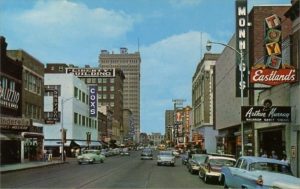 Along these lines I remember a discussion with my father-in-law from back when I first moved here eight years ago. He grew up a few miles outside of Waco. We were talking about new things popping up downtown, and he couldn’t help but hearken back to the “good old days” when he was a kid and his family would drive into town. He told me that back then he was sure that downtown Waco was the biggest, grandest place on earth. This conversation inspired him to take a few minutes to walk down Austin Avenue during his lunch hour, grab a hot dog from George’s and remember the way it used to be.
Along these lines I remember a discussion with my father-in-law from back when I first moved here eight years ago. He grew up a few miles outside of Waco. We were talking about new things popping up downtown, and he couldn’t help but hearken back to the “good old days” when he was a kid and his family would drive into town. He told me that back then he was sure that downtown Waco was the biggest, grandest place on earth. This conversation inspired him to take a few minutes to walk down Austin Avenue during his lunch hour, grab a hot dog from George’s and remember the way it used to be.
As he grew up, downtown changed dramatically. At one point in its history downtown was declared “brain dead”, many of the buildings downtown were boarded up, and new transportation infrastructure investments shifted Waco’s center south or southwest three or four miles.
He told me after his walk that while downtown is not as big today as it was back when he was three and a half feet tall, it still has plenty of potential as a great place. I wasn’t around Waco back then but his story inspires me to look at things from a different perspective and to celebrate the great place Waco is becoming.
Next time you have a few minutes to pull yourself away for just a few minutes, do yourself a favor, park your car and take a walk downtown. Discover something new.
Rediscover downtown on a human scale.
After your walk drop us a note and let us know some of the thoughts inspired by your walk as to what you believe downtown Waco can and should be. We look forward to hearing from you. @1000friendswaco.
Interested in the connection between urban design and human happiness? Join us for Act Locally Waco book club at 6:00 on September 14. We’ll be discussing “Happy City: Transforming Our Lives Through Urban Design” by Charles Montgomery. Email [email protected] for info about how to join us.
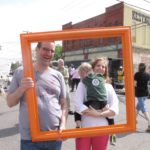 This Act Locally Waco blog post is written by Chris McGowan. Chris is the Director of Urban Development at the Greater Waco Chamber of Commerce. At the Chamber, Chris has been responsible for working with the business community, the public sector and other stakeholders to help revitalize our urban core and strengthen the heart of our city. He is husband of Cristi, dad of Ollie, and for fun he is a charcutier. If you even know what that word means, you are probably eating way too much bacon!
This Act Locally Waco blog post is written by Chris McGowan. Chris is the Director of Urban Development at the Greater Waco Chamber of Commerce. At the Chamber, Chris has been responsible for working with the business community, the public sector and other stakeholders to help revitalize our urban core and strengthen the heart of our city. He is husband of Cristi, dad of Ollie, and for fun he is a charcutier. If you even know what that word means, you are probably eating way too much bacon!
The Act Locally Waco blog publishes posts with a connection to these aspirations for Waco. If you are interested in writing for the Act Locally Waco Blog, please email [email protected] for more information.
(This blog post is part 2 of a two-part series on Grace House. Grace House is a faith-based recovery home for women in addiction. It is currently Waco’s only long-term recovery home for women. To read Part 1, click here. – ABT)
By Karla Wasion
For over two years I have been serving in a recovery home called Grace House. It has been hard, fun, exciting and exasperating all at the same time. But mostly, it has been one of the greatest learning experiences I have ever had. And I am compelled to share with you what I’ve learned.
Everyone has a story. In the two years I have spent ministering to women in addiction, I’ve heard unimaginable stories. And I’ve learned from them things I don’t know I would have learned any other way.
Parenting.
Almost every addicted woman I have encountered was either parented badly, or not at all. Mothers have told their daughters they wish they had never been born. Fathers and step-fathers have used their little girls as sexual toys. They have endured trauma that most of us could never fathom surviving. The most horrific aside, these women rarely heard the words “I love you” or “I’m proud of you”. They were not told they were beautiful or valuable. They were chastised for being fat and had food withheld from them.
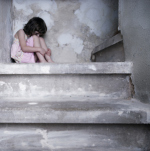 What does a little girl do when she has been taught that she has no value other than her body? What does she do with all of that emotional pain that comes from so much abuse and neglect? She uses her body to survive, and she fills it with whatever will numb the pain and the self-hatred. She becomes the women I have had the privilege of walking with for two years.
What does a little girl do when she has been taught that she has no value other than her body? What does she do with all of that emotional pain that comes from so much abuse and neglect? She uses her body to survive, and she fills it with whatever will numb the pain and the self-hatred. She becomes the women I have had the privilege of walking with for two years.
I’ve learned that parents have an enormous impact on their children. I’ve learned up close the value of telling a child that they are beautiful, wanted and loved. And I’ve learned the impact of parents who do the opposite. I have become more grateful for my own parents who, though flawed themselves, never let me be unloved or unwanted. Though my own story has not been a fairy tale, I am thankful for it now more than ever.
Relapse.
It is part of the addiction recovery process. Prior to this ministry, I would have thought of relapse as failure, or just rebellion. In my own arrogance, I would have written them off. And I would have been so wrong. Relapse is simply an indicator that deeper healing is needed. The pain these women have runs far deeper than most us can imagine, and reactions to that pain are ingrained. I’ve learned that Jesus doesn’t panic over a relapse and neither should I. When a woman returns in repentance and humility, her healing process can continue and her testimony becomes even stronger. I’ve learned about God’s grace through watching women relapse. His grace for them, and His grace for me. Because my own life is not without relapse. I too return to familiar ways when pain becomes greater than I can handle in the moment. I have learned that I am as much in need of grace as anyone, and I have learned from these women how to come back to the Father with humility and accept the grace He so freely offers.
And what of those who do not return? I’ve learned that a woman can truly love Jesus and want to live for Him, but be so afraid of the pain that recovery exposes, that she simply cannot bring herself to return to the process. So I’ve had to learn to let go, knowing that Jesus never will. He will go after them because He loves them and wants their freedom even more than they do. His grace and mercy do not stop at the door of a recovery home, but continues to follow them. I’ve learned that their destiny is in His hands, not mine, so I can loosen my grip because I know that He will not loosen His.
The Father’s voice.
Lies are the glue that holds a stronghold together. I’ve seen and heard the effects of a woman who believes the lie that she is worthless. And I’ve learned that it is not my truth that will set her free. It is the truth spoken to her by her Father that brings a stronghold down. Whether a woman has known Jesus for a year, or for an hour, she can hear the voice of God. I would have doubted that two years ago, thinking that hearing His voice requires maturity. Rubbish. For two years I have spoken truth to women and while it may have brought some relief, it is the loving voice of God that has brought true change. And I’ve learned that I can receive revelation from a broken woman who has heard her Father speak truth. But mostly, I’ve learned that there is just no substitute for hearing my Father speak truth over me to break the power of lies I have believed.
Compassion.
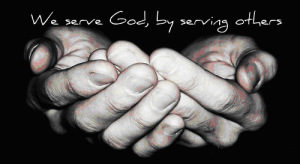 I’ve taken those spiritual gifts tests many times. Every time I’ve taken such a test, it has revealed the same exact thing. My top three gifts have always been the same, and so have my bottom two. I have consistently scored a zero, yes, a zero, in the gifts of Mercy and Compassion. And so I have learned that sometimes God will put you in a place specifically designed to give you what you lack. And I’ve learned that it is not easy to become more like Jesus, especially if you have a big fat zero looming over you. But that’s just it. It isn’t my mercy or my compassion that anyone needs, it’s His. And so I’ve had to learn to ask, over and over, for Him to give me His compassion in the moments when I just don’t have it. When I have been frustrated with someone and wanted to just turn and walk away, He has been faithful to saturate my heart with compassion that compels me to stay, to listen, to understand.
I’ve taken those spiritual gifts tests many times. Every time I’ve taken such a test, it has revealed the same exact thing. My top three gifts have always been the same, and so have my bottom two. I have consistently scored a zero, yes, a zero, in the gifts of Mercy and Compassion. And so I have learned that sometimes God will put you in a place specifically designed to give you what you lack. And I’ve learned that it is not easy to become more like Jesus, especially if you have a big fat zero looming over you. But that’s just it. It isn’t my mercy or my compassion that anyone needs, it’s His. And so I’ve had to learn to ask, over and over, for Him to give me His compassion in the moments when I just don’t have it. When I have been frustrated with someone and wanted to just turn and walk away, He has been faithful to saturate my heart with compassion that compels me to stay, to listen, to understand.
I’ve learned that my zero means Jesus is always the hero. (How cheesy was that?!)
Serving.
Nothing has shown me the value of serving more than this ministry. Without the people who volunteer their time, energy and finances, this ministry would not exist. I’ve seen members of this community of believers, and the Body of Christ at large, give of themselves in extraordinary and selfless ways. Before now, I had been seeing a discouraging trend in the Church, of people only willing to serve if they will get paid. I’ve heard people excuse this trend by talking about how valuable everyone’s time is and that people should not be expected to serve for free. (Yep. Really heard that.) But I’ve watched and I’ve learned that not everyone feels that way. Here, I’ve seen people give up what is so valuable to them for the sake of the Kingdom and the work God is doing, and they give it up willingly and with joy. So I’ve learned that serving is not something that we should be reluctant about, nor does it need to simply be a ‘duty’. It is vital to the health of every ministry, and to the Church. I cannot express how important the service of those who give to this ministry has been, and how encouraging it is to see people want to give up what is valuable for what is better. Watching them has inspired me to want to be a better servant of God.
Missions.
It took a while for me to understand that I was actually on the mission field, and these women were part of God’s harvest. I, like many, considered missions as being somewhere else, somewhere ‘over there’ in a third world country. It isn’t. I’ve learned that being a missionary doesn’t require a plane ride or going to the bathroom in a hole in the ground. It is simply going where God is calling you and doing what He is calling you to do. My mission field is five minutes from home, but I am still a missionary. Laying down your life can happen a mile from home or five thousand miles from home. So I have learned to pray for missionaries regardless of where they are serving, because I have needed so much prayer in this mission field.
There’s so much more. I could go on for days about what God has done in me and taught me in the last two years. Ministering to the broken is hard in every way, but I’ve seen what is harder. Going through the pain of recovery.
To every woman I have encountered in this journey, I tip my hat to you. The rest of the world may not know it, but I know how brave you are. I know how much courage it has taken to keep walking out of bondage. I know how many tears you’ve cried and how hard it has been having to remember things you’ve wanted to forget. I know the fight you have put up when everything in you has wanted to run and hide and numb again when it all got too hard. I have witnessed the depth of the shame you have lain at His feet and the effort it has taken to hold your head up. I know your story and I am so very proud of you for allowing Jesus to have it and to turn it into something that will bring Him glory.
But my knowing all of that is not the best part. Your Father knows all of that and more. He knows all the parts that are just yours and His. Your Father is proud of you. He is for you and with you and in you. He has a destiny for you that you never thought possible. You are loved beyond measure! Don’t give up!
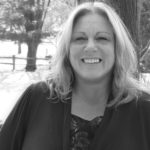 This blog post was written by Karla Wasion. Karla has been a blogger since 2009 and has been on staff with Grace House since 2013. She is currently writing her first book detailing the story of the restoration of her marriage. She and her husband moved to Waco in 2012 from the Chicago suburbs to be closer to their two adult children. Her first grandchild was born in June, and her second one is due in November, so it’s been a big year! You can visit her at www.outofedenministries.com. The ladies at Grace House are desperate for change, but they need help getting there. This ministry is not possible without community partners like you. Please visit our website www.gracehousewaco.com for more information or to make a donation.
This blog post was written by Karla Wasion. Karla has been a blogger since 2009 and has been on staff with Grace House since 2013. She is currently writing her first book detailing the story of the restoration of her marriage. She and her husband moved to Waco in 2012 from the Chicago suburbs to be closer to their two adult children. Her first grandchild was born in June, and her second one is due in November, so it’s been a big year! You can visit her at www.outofedenministries.com. The ladies at Grace House are desperate for change, but they need help getting there. This ministry is not possible without community partners like you. Please visit our website www.gracehousewaco.com for more information or to make a donation.
The Act Locally Waco blog publishes posts with a connection to these aspirations for Waco. If you are interested in writing for the Act Locally Waco Blog, please email [email protected] for more information.


